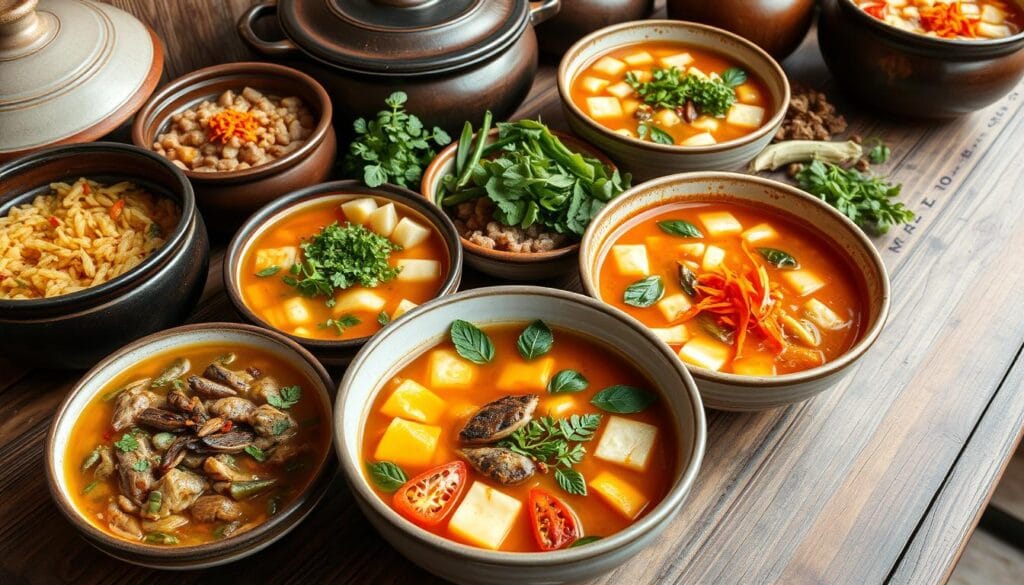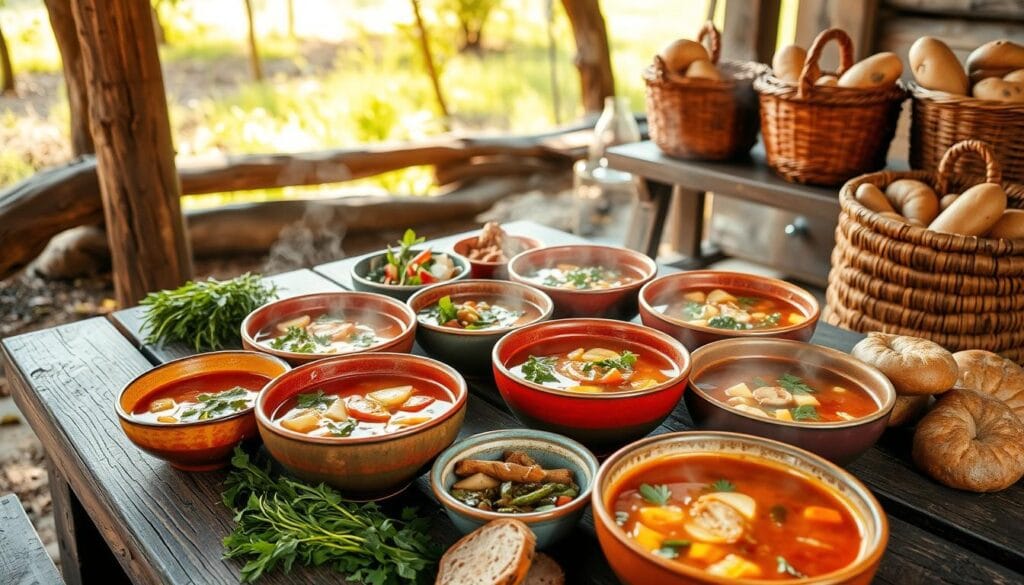Growing up in a small rural kitchen, I learned village soup is more than a meal. It’s a celebration of community and a warm welcome to local cuisine. It connects generations with simple, nourishing ingredients. Every spoonful brings comfort and memories that last forever.
Village soup is the heart of traditional recipes. It turns ordinary ingredients into an extraordinary culinary experience. This comfort food is about sharing, caring, and keeping cultural heritage alive, one pot at a time.
When you make a village soup, you’re not just cooking. You’re part of a timeless ritual. It turns humble ingredients into a rich, flavorful treasure that warms both body and soul.
Key Takeaways
- Village soup represents more than just a meal—it’s a cultural experience
- Traditional recipes preserve community connections
- Local ingredients are the heart of authentic village cooking
- Comfort food has deep emotional and cultural significance
- Cooking techniques are passed down through generations
Understanding the Essence of Traditional Soups
Village soup is more than a meal. It’s a mix of culinary heritage that connects us through generations. These hearty dishes turn simple ingredients into unforgettable experiences.
The Cultural Significance of Community Cooking
Community cooking is more than cooking food. It’s a way to connect people, creating bonds through shared meals. Studies show that cooking together boosts happiness and strengthens relationships.
- Connects families across generations
- Preserves traditional cooking techniques
- Celebrates local culinary traditions
How Village Soups Connect Generations
Village soups are like living history books. They carry stories and memories in every recipe. UNESCO has recognized 30 food traditions as part of our cultural heritage.
“Food is our common ground, a universal experience.” – James Beard
The Role of Local Ingredients
Local ingredients are the soul of village soups. They show off the area’s landscapes and farming ways. Using local veggies like carrots, potatoes, and spinach highlights the area’s culinary traditions.
| Ingredient | Nutritional Benefit |
|---|---|
| Carrots | High in Vitamin A and Fiber |
| Spinach | Rich in Iron and Vitamins A, C, K |
| Potatoes | Good Source of Potassium |
The Rich History Behind Village Soup
Village soup is more than a meal. It’s a journey through time and culture. Recipes passed down through generations share stories of survival, creativity, and community strength.
The history of village soup goes back to hard times. In scarcity, communities found ways to make meals from little. A famous story shows this well:
“Three clever soldiers arrived in a small, impoverished village devastated by a terrible harvest. With nothing but creativity and a large black cooking pot, they began to make ‘stone soup’.”
The soldiers’ creative solution highlighted the importance of regional flavors and cooking together:
- They filled a pot with water and carefully placed stones inside
- Villagers became curious and started contributing ingredients
- Slowly, the soup transformed with additions like:
- Cabbage
- Carrots
- Barley
- Salted beef
- Rich cream
By evening, the whole village was celebrating, sharing a meal that showed unity and resourcefulness. The soldiers were thanked and given bread and cheese. This showed how food can unite people in hard times.
Village soup shows the power of adaptability. It turns simple ingredients into a feast that feeds both body and soul. Each region added its own twist, showing local farming and cultural traditions.
Essential Kitchen Tools and Equipment
Exploring soup making means knowing the right kitchen tools. These tools link the slow food movement with culinary heritage. Your kitchen can turn simple ingredients into memorable meals that connect generations.
Choosing the right equipment is more than just about function. It’s about creating a cooking experience. This experience honors traditional techniques and also uses modern conveniences.
Traditional Cooking Vessels
For traditional soup making, some vessels are better than others:
- Cast iron Dutch ovens
- Clay pottery
- Heavy-bottomed aluminum stockpots
- Ceramic cooking pots
Modern Alternatives for Soup Making
Today, we have new solutions that respect tradition but offer convenience:
- Instant Pot
- Slow cookers
- Electric multi-cookers
- Programmable pressure cookers
Essential Utensils and Gadgets
| Category | Recommended Tools |
|---|---|
| Cutting Tools | Santoku knife, wooden cutting board |
| Measuring | Stainless steel measuring cups, digital scale |
| Stirring | Wooden spoons, silicone spatulas |
| Straining | Mesh strainers, stainless steel colanders |
“The right tools are the silent storytellers of your culinary journey.” – Chef Maria Rodriguez
Investing in quality kitchen equipment improves your cooking. It also honors the rich traditions of soup making. Your tools are more than utensils; they connect you to a timeless culinary story.
Selecting Premium Ingredients for Your Soup
Making a great village soup starts with picking the best ingredients. You want to use fresh, local produce that brings out the true taste of traditional cooking. Using indigenous ingredients adds rich, authentic flavors that make every spoonful special.
- Seasonal freshness of vegetables
- Local sourcing of proteins
- Quality of indigenous spices
- Nutritional value of ingredients
“The soul of a great soup lies in its ingredients, not just its preparation.”
When it comes to proteins, you have many choices that fit the farm-to-table idea:
| Protein Type | Local Availability | Flavor Profile |
|---|---|---|
| Free-range Chicken | High | Rich, Hearty |
| Local Beans | Medium | Earthy, Protein-packed |
| Ground Local Meat | High | Robust, Intense |
Choose fresh and seasonal veggies for your soup. They add color and nutrients. Visit local farmers’ markets for indigenous ingredients that will make your soup stand out. Carrots, potatoes, celery, spinach, and onions are great for a flavor base that connects you to traditional cooking.
The secret to a top-notch village soup is to honor the ingredients and where they come from. By sticking to farm-to-table and using indigenous ingredients, you turn a simple soup into a feast that celebrates local culture and taste.
Foundational Techniques for Perfect Village Soup
Learning traditional recipes is key to making simple ingredients into a masterpiece. Village soup is an art that connects us to our culinary past.
Making a great soup needs precision and care. Let’s look at the basic techniques that make your cooking stand out.
Creating the Perfect Base
The base of a great village soup starts with the right aromatics. Your base should include:
- Freshly chopped onions
- Minced garlic
- Fragrant herbs
- Quality stock or water
“A great soup tells a story of tradition with every spoonful.”
Mastering the Simmering Process
Simmering is key to rich flavors. Start by boiling your ingredients, then lower the heat for a slow simmer. This blends flavors well.
Timing and Temperature Control
Controlling temperature is crucial for flavor and texture. Follow these steps:
- Start with medium-high heat to begin cooking
- Lower to low heat for a gentle simmer
- Stir now and then to avoid sticking
- Check and adjust seasonings as you cook
Remember, patience is the secret ingredient in traditional recipes that transforms a simple soup into a memorable culinary experience.
Regional Variations and Unique Twists

Village soups are true culinary treasures. They show the rich variety of flavors across different cuisines. Each region adds its own special touch to soup-making, turning simple ingredients into amazing dishes.
Let’s dive into the world of regional soup variations:
- Chinese Vegetable Soup: A celebration of local ingredients
- Portuguese Bean Soup: Coastal traditions in a bowl
- Mediterranean Zucchini and Chickpea Soup: Light and nutritious
Regional flavors tell a story of culinary heritage. In China, soups show incredible diversity:
- Northern regions feature hearty vegetables like cabbage and daikon radish
- Southern areas prefer lighter greens and delicate herbs
- Sichuan province adds a spicy kick with Sichuan peppercorns
- Coastal regions incorporate seafood elements like seaweed
“Every soup is a journey through local traditions and tastes.”
Portuguese bean soup shows how local cuisine changes through migration and cultural exchange. From coastal villages to Hawaiian adaptations, this soup tells a tasty story that crosses continents.
Make your village soup a personal masterpiece by trying out local ingredients, herbs, and spices. Embrace the unique flavors that make each soup special!
Seasonal Adaptations of Village Soup
Using seasonal ingredients is key to farm-to-table cooking. Your village soup can change with each season, using fresh and local produce. This way, you connect with nature’s rhythms through your cooking.
Summer Fresh Ingredients
Summer is full of vibrant ingredients for light soups. Your summer soup can feature:
- Ripe tomatoes bursting with flavor
- Tender zucchini
- Sweet corn
- Crisp capsicum
- Fresh herbs like basil and mint
“A summer soup should be as bright and lively as a sunny day” – Local Farm Chef
Hearty Winter Variations
Winter needs warm, comforting soups. Your winter soup can include:
- Root vegetables like carrots and beetroot
- Hearty grains
- Slow-cooked meats
- Warming spices like ginger and thyme
Spring and Fall Transitions
Spring and fall soups blend early and late harvests. These soups mix ingredients like leeks, spring onions, and late-season squash. They offer unique flavors.
Health Benefits and Nutritional Value
Village soup is more than just a comfort food. It’s full of vitamins, minerals, and antioxidants that boost your health. Every spoonful is packed with nutrients to nourish and protect you.
Nutritional Breakdown
- Rich in dietary fiber from vegetables
- Excellent source of plant-based and lean protein
- Loaded with micronutrients supporting immune function
Village soup is great for a balanced diet. It combines legumes, fresh veggies, and lean proteins. This mix meets many dietary needs.
| Ingredient | Nutritional Benefits | Key Nutrients |
|---|---|---|
| Legumes | High protein content | Fiber, Iron, Magnesium |
| Leafy Greens | Boosts immune system | Vitamin A, C, K |
| Lean Proteins | Muscle health support | Essential Amino Acids |
“Soup is a great way to nourish your body with minimal effort and maximum flavor.” – Nutritionist Sarah Green
Pro tip: Make your village soup fit your health goals. Change ingredients and amounts to help with weight or nutrition.
Serving and Presentation Traditions
To make your village soup special, focus on how you serve and present it. Your traditional recipes should be celebrated with thoughtful presentation. This way, you honor your culinary heritage.

Traditional Serving Vessels
Choosing the right serving vessel is key to authentic village soup presentation. Clay pottery, ceramic bowls, and rustic earthenware bring traditional cooking to life. These vessels keep your soup warm and add beauty to your meal.
- Ceramic handcrafted bowls
- Terracotta serving dishes
- Vintage cast-iron soup tureens
Garnishing Techniques
Make your soup stand out with the right garnishes. Fresh herbs, olive oil, or chopped veggies can boost both looks and taste.
- Sprinkle fresh parsley
- Add a swirl of extra virgin olive oil
- Garnish with crisp herb leaves
Accompaniment Suggestions
Pair your village soup with traditional sides for a complete meal. Try crusty artisan bread, a fresh garden salad, or a cheese platter. These additions can turn a simple soup into a feast.
“A well-served soup tells a story of tradition, love, and culinary craftsmanship.”
By focusing on serving details, you not only please your guests but also celebrate your family’s cooking traditions. This is a way to honor your heritage.
Storage Tips and Leftover Management
Keeping your tasty traditional recipes fresh is key. When it comes to comfort foods like village soup, the right storage can make a big difference. It helps keep the flavors rich and enjoyable for longer.
Refrigeration Guidelines
Put your leftover soup in airtight containers to keep it fresh. Homemade soups can stay good in the fridge for 3-4 days. Use glass or ceramic containers with tight lids to avoid flavor loss.
Freezing Strategies
- Freeze soup in portion-sized containers
- Leave slight space at the top for expansion
- Label containers with date of preparation
- Use within 2-3 months for optimal taste
Safe Thawing Techniques
Ready to enjoy your frozen soup? Here are safe thawing methods:
- Refrigerator thawing (recommended)
- Cold water method in sealed bag
- Microwave defrosting
“Proper storage transforms leftover soup from simple meal to culinary treasure.” – Traditional Cooking Wisdom
| Storage Method | Temperature | Maximum Storage Time |
|---|---|---|
| Refrigerator | 40°F or below | 3-4 days |
| Freezer | 0°F or below | 2-3 months |
Pro tip: Always reheat soup gently on the stovetop, stirring occasionally to maintain its original texture and prevent scorching.
Troubleshooting Common Soup Making Challenges
Mastering traditional recipes is key to your culinary heritage. Soup making is an art that needs patience and skill. There are several common challenges to overcome.
“Perfect soup is about precision and careful attention to detail.”
Here are some important tips for troubleshooting:
- Prevent vegetable overcooking by adding delicate ingredients later in the cooking process
- Season gradually to build complex flavor profiles
- Use high-quality, fresh ingredients for optimal taste
Texture and consistency are vital in soup making. If your soup is too thin, simmer it uncovered to reduce the liquid. If it’s too thick, add broth or water slowly while stirring.
| Soup Challenge | Solution |
|---|---|
| Oversalting | Add potato chunks to absorb excess salt, then remove before serving |
| Bland Flavor | Enhance with fresh herbs, quality stock, or a splash of acid like lemon juice |
| Uneven Cooking | Cut ingredients uniformly and stir frequently during preparation |
Remember, becoming skilled in soup making is a journey. It’s rooted in your culinary heritage. With practice, patience, and a willingness to learn, your traditional recipes will become unforgettable meals.
Conclusion
Village soup is more than just a meal. It’s a tradition that brings families and cultures together. It shows how simple ingredients can become nourishing experiences that warm our hearts and souls.
Making village soup is like an art form passed down through generations. Each recipe has its own story, showing off regional flavors and local produce. By learning these techniques, you can create soups that are not just food, but memories to share.
The beauty of village soup is in its simplicity and flexibility. You can make a hearty winter soup or a light summer soup. These recipes let you be creative while keeping traditional cooking methods alive. Your journey with village soup connects you to a world of cooking traditions.
As you keep exploring and trying new things, remember that each soup is a chance to keep cultural heritage alive. It’s a way to nourish your loved ones and create special moments at the dinner table. Village soup is a celebration of community, creativity, and the art of home cooking.
Table of Contents
FAQ
What makes village soup different from other soups?
How can I make village soup if I don’t have access to local ingredients?
Is village soup typically vegetarian or does it always contain meat?
How long can I store village soup?
What are the health benefits of village soup?
Can I modify village soup recipes for dietary restrictions?
What are the best cooking tools for making village soup?
How can I enhance the flavor of my village soup?
Leave us a comment if you like the recipe
There are no reviews yet. Be the first one to write one.
